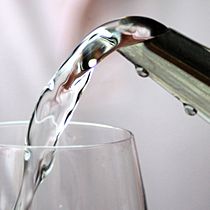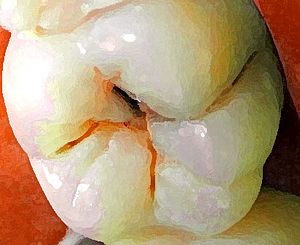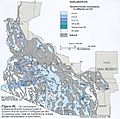Fluoridation facts for kids

Fluoridation is the adding of fluorine compounds (fluorides) to various substances, especially toothpaste and drinking water. Government officials, scientists, and doctors say that Fluoridation helps prevent tooth decay and cavities.
Water fluoridation is the controlled addition of fluoride to a public water supply to reduce tooth decay. Fluoridated water contains fluoride at a level that is effective for preventing cavities; this can occur naturally or by adding fluoride.
Fluoridated water operates on tooth surfaces: in the mouth, it creates low levels of fluoride in saliva, which reduces the rate at which tooth enamel demineralizes and increases the rate at which it remineralizes in the early stages of cavities. Typically a fluoridated compound is added to drinking water, a process that in the U.S. costs an average of about $1.26 per person-year. Defluoridation is needed when the naturally occurring fluoride level exceeds recommended limits. In 2011 the World Health Organization suggested a level of fluoride from 0.5 to 1.5 mg/L (milligrams per litre), depending on climate, local environment, and other sources of fluoride. Bottled water typically has unknown fluoride levels.
Dental caries remains a major public health concern in most industrialized countries, affecting 60–90% of schoolchildren and the vast majority of adults. Water fluoridation reduces cavities in children, while the effect in adults is less clear.
Although fluoridation can cause dental fluorosis, which can alter the appearance of developing teeth or enamel fluorosis, the differences are mild and usually not considered to be of aesthetic or public health concern. There is no clear evidence of other adverse effects from water fluoridation.
Fluoride's effects depend on the total daily intake of fluoride from all sources. Drinking water is typically the largest source; other methods of fluoride therapy include fluoridation of toothpaste, salt, and milk. The views on the most efficient method for community prevention of tooth decay are mixed. The Australian government states that water fluoridation is the most effective way to achieve fluoride exposure that is community-wide.

Public water fluoridation was first practiced in the U.S. As of 2012, 25 countries have artificial water fluoridation to varying degrees, 11 of them have more than 50% of their population drinking fluoridated water. A further 28 countries have water that is naturally fluoridated, though in many of them the fluoride is above the recommended safe level. As of 2012, about 435 million people worldwide received water fluoridated at the recommended level (i.e., about 5.4% of the global population).
Despite this, the practice is controversial as a public health measure; some countries and communities have discontinued it, while others have expanded it. Opponents of the practice argue that neither the benefits nor the risks have been studied adequately, and debate the conflict between what might be considered mass medication and individual liberties.
Other pages
Images for kids
-
Detail of southern Arizona. Areas in darker blues have groundwater with over 2 mg/L of naturally occurring fluoride.
-
A mild case of dental fluorosis, visible as white streaks on the subject's upper right central incisor.
-
Fluoridated iodized salt sold in Germany
See also
 In Spanish: Fluoración del agua potable para niños
In Spanish: Fluoración del agua potable para niños








